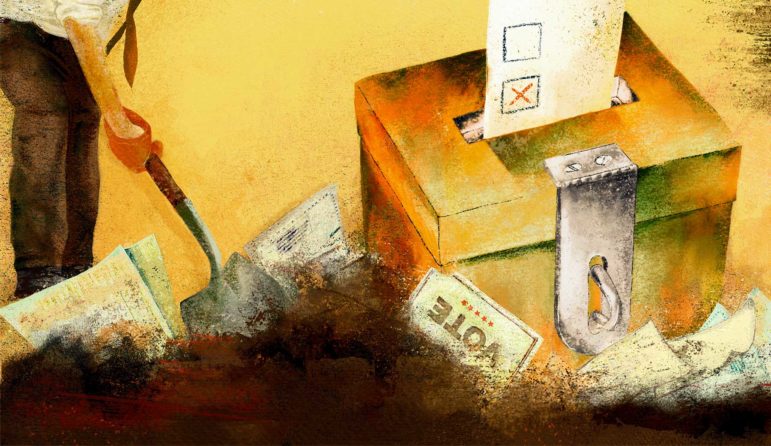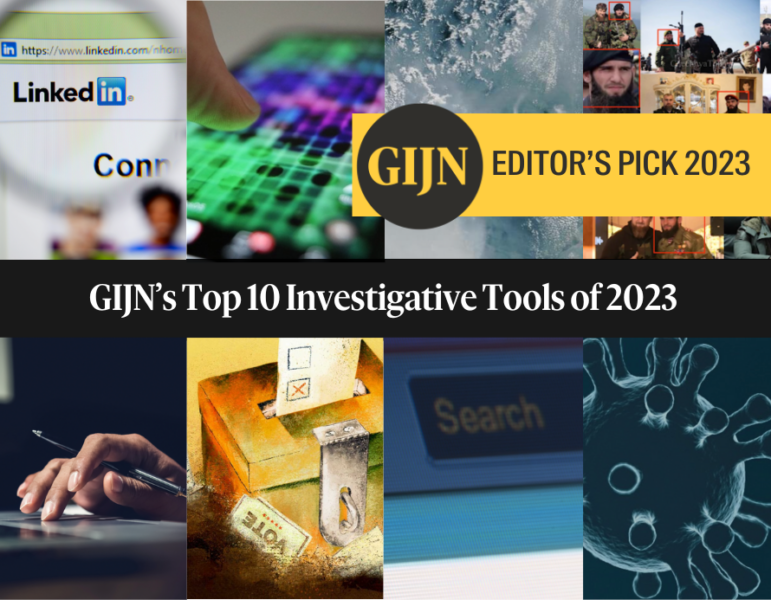

Illustration: Marcelle Louw for GIJN
Revised Elections Reporting Guide for Investigative Reporters: New Digging Tools
Read this article in
Chapter Guide Resource
Revised Elections Guide for Investigative Reporters: Where to Begin
Chapter Guide Resource
Revised Elections Reporting Guide for Investigative Reporters: New Digging Tools
Chapter Guide Resource
Revised Elections Guide for Investigative Reporters: Preparing for Elections
Chapter Guide Resource
Revised Elections Guide for Investigative Reporters: Investigating Candidates
Chapter Guide Resource
Revised Elections Guide for Investigative Reporters: Political Messaging and Disinformation
Editor’s Note: This reporting guide has been updated and revised for the 2024 election cycle. It was originally published in 2022 and the previous version of this chapter can be read here.
One overarching strategy for reporters covering elections in 2024 should be to adopt a new mindset: never underestimate the lengths politicians and their allies might go to to cheat voters or silence critics.
At the 13th Global Investigative Journalism Conference (#GIJC23) in Sweden in September 2023, Vinod K. Jose, former executive editor of India’s Caravan magazine, offered the extreme example of the assassination of a Sikh activist in Canada in 2023 — allegedly, at the direction of the Indian government.
“I don’t think anything remotely like this would have happened 10, 15 years ago,” said Jose. “It speaks to the kind of confidence that these elected autocratic leaders get from watching each other do bad things, and survive.”
In Brazil, supporters of outgoing president Jair Bolsonaro staged a violent, orchestrated insurrection in the capital in early 2023, in a near repeat of the storming of the US Capitol building on January 6, two years earlier, by insurrectionist Trump supporters. In both cases, insurrectionists were encouraged by executive officials in the two largest democracies in the Western hemisphere.
The alarming trends go beyond individual demagogues. Some of the world’s largest democracies are threatened by populist politics and either minority rule or its opposite: extreme majoritarian rule, in which the rights of minority groups are crushed by nationalist ruling parties.
At that same GIJC23 panel, Pulitzer Prize-winning reporter David Cay Johnston said that — in parallel with their campaign reporting — watchdog reporters need to actively investigate the shadowy foot soldiers that quietly erode citizens’ rights. He called these actors the “termites” who eat away at the foundations of democracy.
Said Johnston: “How do you ensure minority rule? By making it harder for majority supporters to register to vote or easier to disregard their ballots. By appointing people to unsexy but strategically important administrative positions. By controlling the way political districts are designed.”
“They’re often not sexy stories, but investigative reporters need to pay attention,” he added.
Reviewing the Landscape of Election Investigative Tools
In this chapter, we share some effective election-digging strategies that experts say are often overlooked, as well as some go-to open source tools, and a powerful technique for identifying the individuals behind dangerous or hateful campaign sites. These resources include past input from experts including Jane Lytvynenko — a leading investigator of political extremist groups — and ProPublica’s media manipulation guru Craig Silverman.
Since election rules, civic freedoms, and dominant information channels are different in each of the more than 150 countries that hold elections, there is no single investigative tool or technique that can be equally effective everywhere. But there is a small group of established, all-purpose digging tools and methods that are remarkably effective for many, or even most, countries and election topics.
Here are four examples of election digging techniques that require no advanced computer skills:
-
Boolean search. No matter their level of digital skills, leading investigative reporters around the world rely on the Boolean Google search method to laser focus Google’s data-finding power — either with combinations of established search operators, or advanced Google “dorks.” For instance: if you’re wondering if a candidate has a possible past connection to a criminal or sanctioned individual, and have limited time, try entering the following sequence —“name of candidate” “AROUND(18)” “name of criminal” — into Google’s search bar, and it will look for documents where those two names appeared in the same sentence. Another technique that is surprisingly powerful in identifying individuals behind political disinformation is the “excluding trick” — where you can paste a post’s URL and then exclude entire social media platforms with a minus sign, like: “-site:youtube.com” or “-site:Instagram.com” to see where else, or where first, a problematic election-related video appeared.
-
The “store manager trick” to investigate political violence. Zoom in on the site of an incident of political violence in urban areas on Google Maps; call the numbers of the nearby stores that will pop up; and then ask the store managers first for their email address, and then for access to their exterior security or CCTV video feeds. Many, or sometimes most, will at first decline to share those feeds. But veteran political reporters say the real “trick” is, soon after, to send a copy of your first story of the incident to those managers by email, and ask them for that CCTV footage again. They report that, in many cases, managers will change their minds after seeing evidence of your even-handedness as a journalist.
-
The easiest possible way to check for hidden influence campaigns: copy-paste-search. If you encounter an election-related site with problematic or inflammatory content — but no information on the site owner — then just copy any chunk of text from the home page into the Google search bar, and see if any other sites with the same, or similar, content pops up. If you find similar text blocks on other sites, this could suggest a hidden, coordinated influence campaign, and also point to the owner or political campaign behind the original site. (Also, look out for similar logos and layouts, as these could indicate the involvement of the same web designer.)

Illustration: Marcelle Louw for GIJN
-
The “geocode” trick to track campaign incidents. Auto-gathering social media posts from a single, targeted location in the TweetDeck tool was a powerful way to investigate political incidents in recent years. Unfortunately, more recent changes at X mean that access to TweetDeck (renamed “X Pro”) now requires a broader, paid-for subscription with X. But it still works well in channeling videos and posts from a protest or rally in real-time, and reporters can use it, for instance, to identify perpetrators, or quickly debunk campaign claims that falsely blame the violence on victims. Having copied the coordinates of an incident from the “What’s here” tag on Google Maps, reporters can paste that string alongside the term “geocode:” in TweetDeck, plus a distance radius, to channel all social media posts and video from that area into a single column. The steps are set out in this explainer from Bellingcat. For those who may wish to avoid X tools, try alternative tools like Hootsuite. (Note: If you know a better open source option, please share it to hello@gijn.org and we’ll update this chapter.)
And here are four more all-purpose examples for investigators:
-
The Aleph database. Journalists have successfully dug into election-related financial irregularities and hidden connections in different parts of the world with OCCRP’s vast Aleph document leaks database. This resource now also includes a “cross-reference” feature, in which you can search hundreds of other databases on Aleph for names that crop up in your own, uploaded file.
-
Junkipedia. Following declining reporter trust in Facebook’s powerful social media analysis tool CrowdTangle, a remarkably versatile new digging tool called Junkipedia has quickly become a go-to platform for tracking election disinformation campaigns and problematic posts and websites. It allows users to build social media account lists from 12 different platforms, including sites favored by far-right groups, like GETTR and Gab, as well as major sites like TikTok, Facebook, and Telegram.
-
Psiphon, to reach oppressed citizens. One of the most innovative and important new tools for citizens of autocracies in recent years is Canada’s Psiphon platform, a sophisticated censorship circumvention tool that allows voters to access independent information about their rights and governance without realistic risk of discovery or reprisal. Available on Android, Windows, and iOS platforms, Psiphon 3 uses free, open source software and a combination of secure servers, encryption, and “obfuscation technologies” to camouflage connections and connect users to blocked news sites in restricted nations. Exiled and under-fire newsrooms can consider alerting their audiences to this method of connecting to facts on their country’s elections as it is more secure than traditional VPNs. See the Psiphon user guide at this link, or check out ProtonVPN.
-
Bellingcat Auto Archiver. With election violence an increasingly pressing issue, preserving video evidence — previously, a complex and fraught process — will be critical in 2024 and 2025. In response, Bellingcat’s tech team have developed a new tool that allows reporters to simply copy and paste a video’s URL into a dedicated spreadsheet, and the system then automatically finds the best downloading and archiving strategy for each clip. (See the links in GIJN’s “Top 10 Investigative Tools of 2023” for access and set up.)
Why Reporters Should Dig Beyond What Is Merely Illegal

In 2023, ProPublica uncovered a legal — but ethically dubious — campaign to challenge nearly 100,000 voter registrations in the US state of Georgia. Image: Screenshot, ProPublica
Pro-democracy advocates say that one important strategy for investigative editors is to map out and monitor the known points of attack against democratic processes, early in campaigns. These include not only the abuse of human rights and violation of election laws, but also the partisan use and abuse of duly enacted laws. For instance: in 2023, an investigation by ProPublica revealed that just six right-wing activists in the US state of Georgia had formally challenged the eligibility of 89,000 fellow voters, after exploiting a new election law. The investigation revealed the alarming potential for mass intimidation, administrative obstruction, and voter suppression behind these private challenges, which often require thousands of fully eligible voters to either spend money to attend hearings or jump through bureaucratic hoops to disprove frivolous claims from a single citizen challenger, and remain on their voter roll.
Meanwhile, a recent report by the pro-democracy Brennan Center for Justice nonprofit revealed the anti-democratic threat posed by a new voter suppression tool called Eagle AI, which can “auto-prepare” mass voter challenges, and which harnesses a flawed, partisan database of public voting data and local election rules to supply bad-faith activists with the minimum “evidence” to challenge the fundamental rights of fellow citizens. (The Brennan report found that simply living at a nursing home, or filing a social media post far from home, can count as evidence for some legal voter registration challenges.)
In an interview with GIJN, Josh Visnaw, project manager at VoteFlare — a voter empowerment tool based at Harvard University’s Kennedy School of Government — said this new private voter challenge mechanism in the US illustrates a broader issue that journalists in all democracies need to confront in the current populist era, from Europe to Africa. While reporters are comfortable with digging into and exposing illegal actions — or at least acts contrary to the intention of laws — Visnaw said reporters also need to investigate, and fully unpack, the legal use of anti-democratic mechanisms that do reflect the intention of the laws.
Visnaw listed several dirty tricks that concerned him most ahead of the 2024 US election — from mass voter roll purges to threats of voter prosecution from far-right governors — but agreed that the voter challenge issue highlighted by the ProPublica investigation was his biggest worry.
“It’s similar to doxxing — imagine: any individual can challenge the status of your voter registration with an automated tool, based on faulty data,” said Visnaw. “I could say ‘Joe Smith, I don’t think you are properly registered to vote in Michigan, because, say, I heard you had a house in Florida.’ At the least, this jams up the election system.”
Election Digging Strategies to Consider
1. Find Local Tips and Databases Through Citizen Monitors
Experts and GIJN member newsrooms that have dug into elections say that while effective databases and tools are essential, most consequential investigations begin with human sources. These include whistleblowers, law enforcement and civil society professionals, election managers, low-level campaign staffers — and, importantly, ordinary citizens who care about democracy.
Pat Merloe, director of electoral programs at the US government-funded National Democratic Institute, says a wealth of information is available to journalists from the hundreds of nonpartisan election monitoring groups around the world. NDI’s country-by-country database includes 251 vetted organizations in 89 countries. He says reliable groups are an underused resource for independent media, and that, crucially, they can also direct reporters to the up-to-date local election rules and datasets they’ll need to assess legal compliance by campaigns and supporters. As examples, Merloe cited the Christian Churches Monitoring Group (CCMG) of Zambia, which deployed 1,108 observers to Zambia’s 2021 presidential by-election, as well as The Young Lawyers Alliance and ISFED (International Society for Fair Elections) in Georgia.
“Some might be looking at election violence; some might be looking at disinformation; all would be looking at questions about the integrity of the voter lists, the locations of polling stations, the 10 things to watch out for on election day — these are the folks I’d reach out to,” says Merloe.
2. Report as If Your Country Is a True Democracy — Even If It Isn’t
One important general strategy for covering elections in countries already gripped by authoritarian rule is, where possible, to report as if the country is a functioning democracy. In other words, pursue even those campaign corruption stories that will likely not result in arrests or firings or recorded voting changes, because, as Lina Attalah, chief editor of the Egyptian site Mada Masr, has pointed out, this approach helps prevent self-censorship, and keeps the bar high for voter expectations of public ethics.
3. Crowdsource Evidence of Election Dirty Tricks
If your country’s election conversation is dominated by non-public messaging platforms like WhatsApp — as is common in Southern Africa or Latin America — experts recommend that newsrooms publish a WhatsApp tip line number through the Google Voice app. Then, use that resource to enlist audiences to report any false election claims, voter registration dirty tricks, or extremist intimidation that they encounter. What’s more, experts recommend that rival newsrooms collaborate and use the same tip line number, working together to reveal anti-democratic misconduct and then tracing it back to the source.
This technique is also important for established democracies, especially for exploring disinformation robocalls. Tracing those responsible for calls falsely threatening added tax scrutiny for voters, or advising minorities incorrect information about election day, has, surprisingly, emerged as one of the toughest technical problems facing reporters. However, experts agree that crowdsourcing data from these calls is the best place to start.
4. Try Simple Boolean Google Searches — and Repeat
As mentioned above: advanced Boolean search tricks and “Google dorks” are powerful for narrowing online searches to the data you need. However, a striking takeaway from GIJN’s interviews with experts for this guide was how basic, rapid, and trial-and-error their digital searches tend to be. For instance, we watched Nancy Watzman — an investigative journalist and consultant to New York University’s Cybersecurity for Democracy project — run Google searches for plots of voter intimidation, and, most of the time, she simply used alternating, carefully thought-out keywords along with the basic terms AND and OR in the same Google search bar that we all use.
-
Here is one such example of simple Google searches from Watzman’s digital reporter’s notebook. After the January 6 riot at the US Capitol in 2021, she used a series of paired terms to check for threats of violence to the inauguration of President Joe Biden on January 20: “patriot” AND “march” (OR “rally” OR “january 20” OR “jan 20” OR “fraudulent election” OR “ashli babbit” OR “storm” OR “capital” OR “capitol”) as well as “inauguration” AND “march” (OR “rally” OR “storm” OR “fraud”).
Google itself, Watzman says, is immensely powerful for election digging — if we think in terms of the way the search engine, and the people we’re investigating, tend to think, and just keep trying.
5. Manage Voter Expectations
The role of investigative reporters should not only involve accountability and wrongdoing in elections, but also effective public service journalism that underlines the truth of the facts reported, and the legitimacy of elections. This includes visualizations — with excellent open-source tools like Flourish — to counter false fraud claims, foster newsroom collaboration, and set voter expectations for normal delays and typical errors in election counts. Experts also recommend clear “Why we did it” story explainers to promote media trust in politically polarized countries. Lynn Walsh, assistant director at Trusting News, suggests that reporters embed “Why/How we reported this” boxes prominently in the body of investigative election stories, and that they consider candid, first-person video clip explainers by the reporter as well.
Case Study: How the UA/Pub Tool (And Greed) Can Expose Hidden Hate Speech and Propaganda Networks
Online sleuth Craig Silverman has advanced the cause of election accountability through the open release of his comprehensive Verification Handbook, and by briefing numerous journalism groups on the use of new digital tools, from the US to the Philippines. Given the global threat posed by shadowy election websites that promote hate and conspiracy, one technique Silverman has shared — known as the “UA/Pub method” — deserves its own in-depth profile.
Its value is rooted in two advantages. First, despite the seemingly complex code you encounter, it actually requires no advanced skills at all. And second, it takes advantage of the personal greed that motivates many election bad-faith actors.
There are many reasons prominent figures in elections, whether campaign staff or special interest lobbyists or donors, don’t want the public to know that they are the true force behind certain individual websites. For instance, those sites could contain hate speech, disinformation, or illicit links to foreign powers.
Are they willing to sacrifice the credit for those websites to keep themselves hidden? Yes, and many can and do choose domain privacy settings to remove their names. But are they also willing to sacrifice the ad revenue that trickles in thanks to those sites? Probably not, Silverman reasons, which allows investigative reporters to track the people behind toxic, election-related websites.
How the UA/Pub Tool Works
-
The people behind millions of websites have signed up for the free Google AdSense service, which then automatically populates their sites with ads. To receive revenue from those ads, the website owner needs to add a unique AdSense code string to their website source code — which always begins with “Pub-”.
-
Likewise, millions of site owners have also signed up for the free Google Analytics service, which shows them the size and origin of their audience. To receive this data, they also need to add a simple, unique code to all the sites they control, which always begins with “UA-”.
-
Crucially, site owners typically use the same ID tags, so Google knows to whom they should send both the money and data generated.
-
Reporters can find either the identifying Pub or UA tags in any website source code (see those steps below), and paste them into any of three free tools — BuiltWith, SpyOnWeb, or DNSlytics — and quickly see all the other sites that also use those same revenue or data tags. This way, they can potentially find the networks and individuals behind mysterious election sites.
-
Remarkably, the UA/Pub method also works with inactive or even long-dead websites. So reporters can potentially find how the same campaign actors profited from, say, opportunistic disinformation in prior election cycles, or were part of different or evolving domain networks. Silverman says reporters who have pre-installed the Wayback Machine Browser Extension can automatically get popup messages during their normal UA/Pub searches — alerting you to the fact that the tool has archived copies of former sites spat out in your investigation. You can then perform the same, simple UA/Pub search method on the archived pages, to search for the same tags. “Isn’t that an amazing, super-easy thing?” says Silverman. “It tells you right away, because you have the extension installed, and you can then do the same source code trick.”
“This is the most fundamental way I use to connect websites together,” Silverman concludes. “Even though it may seem technical, it’s really straightforward, and I really encourage reporters to practice this on sites you come across in elections.”
He says the AdSense “Pub” publisher ID, in particular, represents a strong indication that the same person or group is behind apparently unconnected sites. “The money earned from ads connected to the same publisher tag are all going to go into the same account,” he explains. “It’s very unlikely I’m going to put someone else’s Google publisher ID on my site, because they’ll earn all the money from my ad display.”
How to Find and Use the UA/Pub Tags
-
Right-click on the white space of any webpage, and go to “view source code” or “show page source”.
-
Don’t be intimidated by all the source code that appears! Simply use Control-F — or “Find” in the Edit menu — to search for either “UA-” or “Pub-” on the source code page.
-
Copy the whole tag you may find — including UA or Pub and the numbers that follow.
-
Open DNSlytics.com and paste the copied tag into the search bar. The search should return a clickable list of any other website domains that have used the same revenue or analytics tag. Note: this could include now-defunct sites that used the tag in the past.
-
Repeat the same, brief process with the SpyOnWeb and BuiltWith tools because additional results often pop up, including inactive sites. Silverman says BuiltWith also works just with the URL from the website you’re investigating, but encourages journalists to manually search for the UA and Pub numbers as a means of verifying the unique connection between sites.
-
Repeat the UA/Pub search on archived pages you find on the Wayback Machine.
-
Confirm or expand your findings by dropping the URLs you come across into Whoisology.com and DomainBigData.com, and searching the available history for information gained in the UA/Pub search.
Note: If you know of a great new tool or database that can help reporters dig into elections, please share it with us at hello@gijn.org.
 Rowan Philp is a senior reporter for GIJN. He was formerly chief reporter for South Africa’s Sunday Times. As a foreign correspondent, he has reported on news, politics, corruption, and conflict from more than two dozen countries around the world.
Rowan Philp is a senior reporter for GIJN. He was formerly chief reporter for South Africa’s Sunday Times. As a foreign correspondent, he has reported on news, politics, corruption, and conflict from more than two dozen countries around the world.













